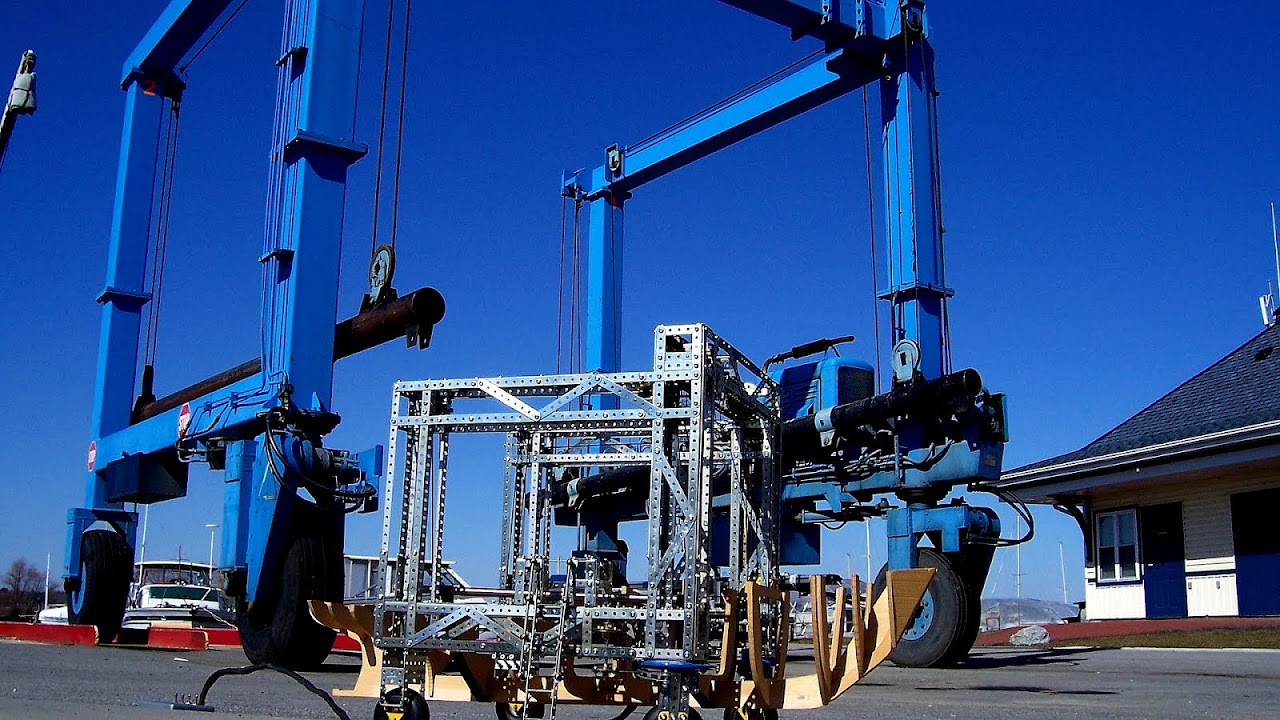
A shiplift is a modern alternative for a slipway, a floating dry dock or a graving dry dock. A shiplift is used to dry dock and launch ships. It consists of a structural platform that is lifted and lowered exactly vertically, synchronously by a number of hoists. First, the platform is lowered underwater, then the ship is floated above the support, and finally the platform with shipsupport and ship is lifted and the ship is brought to the level of the quay.
Nowadays, shiplift are most of the time supplied under rules of a classification authority. Lloyd's Register of Shipping is the authority with most experience in the certification or classification of shiplifts. Whereas "shiplift" is the word that is normally used, the term used by Lloyd's register is "Mechanical Lift Dock".
It will be discerned between two different kinds of platform design, the articulated and the rigid. The articulated platform has hinged connections between the main and the longitudinal beams, this type is amongst other things favored by Syncrolift and TTS. At the rigid platform, the beams are bolted or welded together. The advantage of the rigid system is a better load distribution and the safety against rope break. This type is amongst other things favored by WETEC Group and TTS.
The Syncrolift System was invented by Raymond Pearlson, who was later awarded the Sperry Award for the invention, development and worldwide implementation of a new system for lifting ships out of the water for repair and for launching new ship construction.
It is important to synchronize the winches. Modern systems use electrical control and drive systems for the winches. Old fashioned electrically driven shiplift systems needed so much starting current that they often could only be used in the weekend when other electrical equipment was not in use. The modern shiplifts however do not have this disadvantage; they can start the movement in any desired curve.
In 1967 Hydranautics, now Bardex Corporation, designed, patented, manufactured and delivered the first shiplift using chain instead of wire rope. These Shiplifts differ distinctly in the use of hydraulic Chain Jacks and Stud Link Anchor Chain to lift commercial ships, naval vessels and submarines.
The five distinct advantages to the Bardex Chain Jack Shiplift are: 1) Chain is inherently less susceptible to corrosion and bending fatigue as any chain corrosion is visible on the outside surfaces as opposed to wire rope. For this reason, Lloyd's shipping register requires 20% of wire ropes to be removed and destructively tested each year with all wire ropes to be replaced every 5-10 years. Lloyd's does not stipulate any specific duty life limitations for chains which have been known to last for over 20 years in operation. 2) Traditional wire rope shiplift systems rely on synchronous motors powering the winches. These motors cause a large power demand on the system when started. Hydraulic systems start at no load so there is no excessive inrush current demand. 3) The use of dual chains for redundancy in lieu of a single wire rope at each hoist provides extra safety and reliability. 4) Use of chain allows incremental mechanical synchronization of the entire lift operation. The chain links are made to very tight fabrication tolerances so that after each jacking stroke, the platform is set down on the next set of chain links and the level has been "reset". Wire rope hoist by comparison can become cumulatively unsynchronized over the duration of a lift requiring the operation to stop and be adjusted. 4) At all times the shiplift and the vessel are mechanically held by chain resting on support pins not relying on a braking system. 5) Holding the rigid shiplift platform at the correct elevation for Transfer Operations is a locked mechanical function as the chain is pinned in position without the deflection inherent in wire rope systems. A Bardex Shiplift has never dropped a vessel.

Maps, Directions, and Place Reviews
Transfer System
Many shiplifts use a transfer system for ships so that the vessels can be transported from the water to a parking place where they can be painted or repaired. One shiplift can serve many parking places, while a dry docking installation can only dock one ship.
For large vessels the transfer system consists of a number of trolleys or cradles, supported by high capacity steel wheels. The wheels drive on heavy duty rails. The transport can be one directional, but in order to serve more parking places, two directional systems are used. These two directional systems make use of a traverser carriage or sometimes the wheels of the trolleys can be turned over 90 degrees. Above the wheels often hydraulic cylinders are located so that the ship can be transported upon a so-called "Fluid Bed". The cylinders are also used to lower the ships on a static support, so that the transfer system with the active elements can be recovered.
The Bardex Longitudinal and Lateral Transfer System utilizes remote operated hydraulic, self powered Bogies (trolleys) with passive hydraulic suspension systems. Transfer of 12,000+ ton vessels to and from the Shiplift and across the shipyard is smooth as the suspension compensates for slight elevation changes. This suspension system also means that the shipyard and shiplift pier 'civil works' structural bearing design can be designed with lower peak loads.
Used Marine Travel Lift Video
Pleasure Craft
Smaller devices called "Boat lifts" are available that simply raise yachts, sailboats, or small watercraft above the water level at a dock for storage, for reduced maintenance cost and increased security. They can be operated by cables, by hydraulics, or by air flotation and some are "drive on" to segmented flexing supports.
Even smaller, are devices sometimes called "Portable boat lifts" which are easily transported cranes that allow one person to separate a boat from a trailer by themselves.
Source of the article : Wikipedia


EmoticonEmoticon